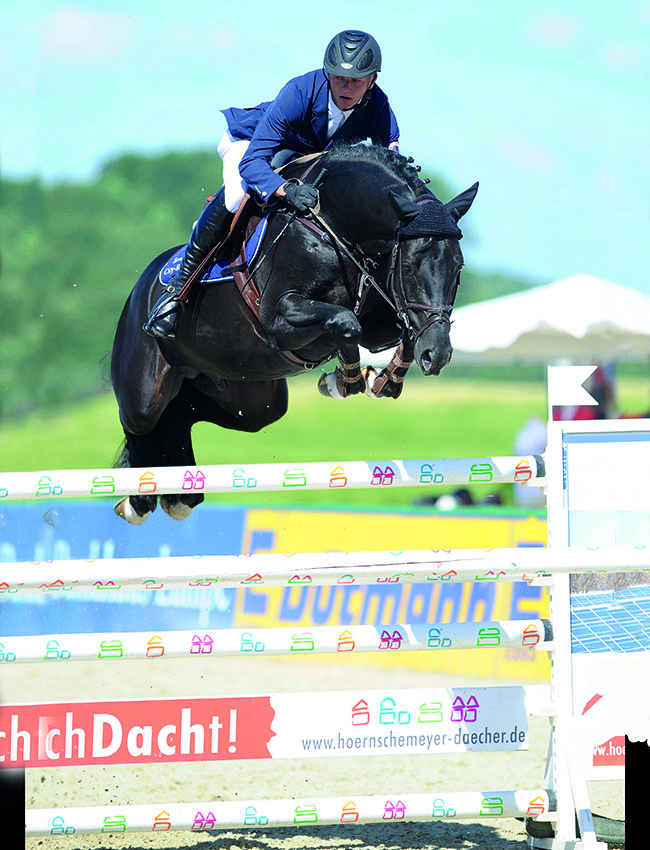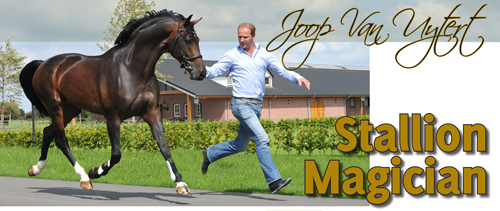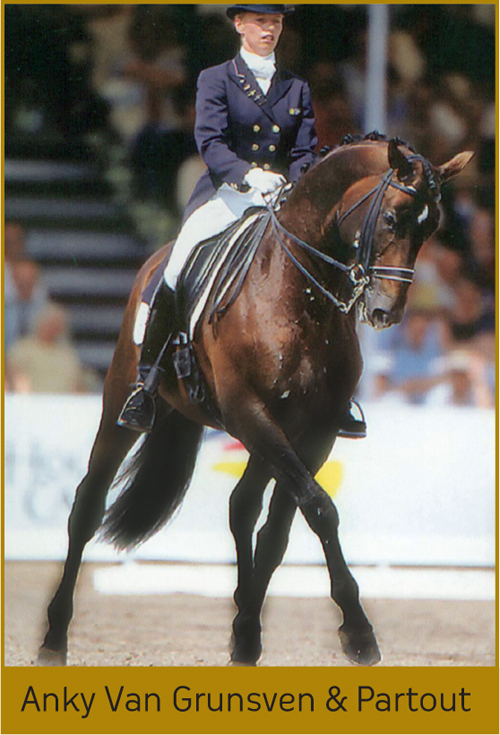Words by Chris Hector & Photos by Roz Neave
Joop Van Uytert is sort of Holland’s answer to Paul Schockemohle, and it is really not surprising that they work together, marketing each other’s stallions and in some cases, owning stallions in partnership. Unlike Paul, Joop was never a competitor, and unlike Paul, whose first love was jumping and jumping horses, Joop, was the first of the Dutch stallion keepers to focus on the emerging dressage market. It was a seriously good move…
Joop showed us around his farm, he’s one of those guys who moves fast, and talks faster, and it is quite a tale:
“We started in 1993, and in the first year, we bred with our KWPN-licensed Trakehner stallion, Balzflug. My father-in-law bought him, he covered 200 mares in that first season, and that was our start.”
Balzflug was to be quite an important stallion in the development of Dutch dressage breeding, and this year, he was the dam sire of the Dressage Champion at the KWPN licensing, Etoine, who is by another Van Uytert stallion, Vivaldi.
Joop wasn’t only quick to see opportunities for a specialist dressage sire, he also realised that to really get the mares, his stallions had to be out in the competition arena, and again, he chose his riders well:
“I had a good contact with Anky van Grunsven and we started with the stallion, Partout, and they were very successful. We bought Gribaldi as a young stallion. That was the first stallion I bought, I was 26 or 27 then, I saw him as a young horse, two-and-a-half, and it was incredible what a horse he was – his movements were good but his type was magnificent. He brought very good breeding to Holland.”
Business was growing… fast.
“We started the first year with 200 mares, then we had 400 mares, then 800-1000, now always between 1000 and 1500, and in the last four or five years, we have added a lot of young stallions. We have United, we have Vivaldi, Sandreo was licensed, Tango was licensed, we have Zhivago, we have Zizi Top, we have some German stallions. We also bought with Paul Schockemöhle, the stallion, Diarado.”

Diarado – available in Australia from IHB www.IHB.com.au
“For the last two years we have had around 2000 mares. It’s a lot of work, but that is our living, we were the ones who started with dressage. There are a lot of stallion stations in Holland; Nijhof, van der Lageweg, Zangersheide, all jumping. We are just dressage, and we knew Anky very well, and we know Edward Gal because when he started riding, he started with me.”
Joop not only has a keen eye for a horse, it would seem he is something of a matchmaker…
“Seven years ago, there was a stallion show in Germany, and Edward was there with Vivaldi, and Hans-Peter Minderhoud was there with Painted Black. They said in the evening to me, ‘where do we sleep?’ and I said, ‘you can sleep in that room’ – and they have been together ever since. We do a lot with Edward and Hans-Peter. We have a lot of our stallions out with riders. Gribaldi was with Edward, United is with Edward, Vivaldi is with Hans-Peter, Tango is with Hans-Peter. In the morning we go to Holstud to collect semen, then the girl is coming back with the semen for our place, or to go all over Europe.”
But Van Uytert also has a stallion with his first star rider, Anky:
“We started with Anky and Partout. She also had Cocktail, and now we have the new stallion, Upido, from Spain, with her.”
“We have every year a big show here of our dressage stallions with 2000 people. It is so busy – we have two days dressage and one day jumping.
And he has a new stallion – Metall. ‘I bought him the day after Uthopia went so well at the European Championships!”
You must be pretty good at predicting the future… When everyone in Holland was breeding jumping horses, you decided to specialise in dressage…
“We had a little bit of luck of course. Anna, my wife, was riding dressage, and we knew Anky well, and dressage has been coming up and up. We have had some very good dressage stallions, Gribaldi, Cocktail, Partout – then we bought foals of those stallions, and one of our best young breeding stallions is United, and United is by Krack C out of a mare by Partout. We have a lot of combinations with that blood.”
Interesting that you went to Trakehner stallions because in Germany at the time, many of the breeders had given up on Trakehners, they were pretty, but couldn’t do anything…
“In the beginning of dressage in Holland, we had the Trakehner, Doruto, and he produced a lot of dressage horses. Gribaldi produces a lot, also Michelangelo. I think the Trakehner did a really good job in Holland.”
But the good ones seem to be by Trakehner stallions out of a mare with jumping blood…
“It is always a combination. What the Trakehners have, they are hard horses. Good in their legs. Look at Gribaldi, he was never lame, he was 13 years old when it was the first time he had the vet. Partout was also a hard horse – and that is important.”
But the good ones seem to be out of mares with jumping blood, Nimmerdor, Goodtimes…
“That is interesting, the jumping horses are always good for the canter. We started with the Gelders horses, the work horses, we have now four or five generations of dressage blood. It is important to keep mixing it in the future, ten generations of dressage blood is maybe too much, you need a little jumping blood.”
“Look at Ferro, he started in jumping, and look at the top horses at the European Championships, Uthopia is by Metall, and Valegro by Negro, both by Ferro.”
What do you think Metall will bring to the breeder?
“He makes the power, the power comes from Ferro. He has a very good dam line, Ramiro, then Marinier…”
Jumping blood again…
“Real jumping blood but with the Ramiro blood you see a lot of his blood in the dressage horses. Ramiro was a little bit both, Ramiro was one of the best stallions in the world.”
Is it tough, having to come up with a new stallion every season?
“We have a lot of competitors, so yes, it is very tough.”
It is important for your stallions to compete?
“Very. We started with Partout, he was Grand Prix, it is important for the stallion to show he can compete at the highest level. Gribaldi was at the highest level, Cocktail was at the highest level, Painted Black, Tango is now, and United is coming, Vivaldi is coming. A lot of our good breeding stallions do compete at the highest level, it is very important. You see it also in jumping. A few years ago, you had Baloubet du Rouet who was very good in himself, but not a stallion – now you see it, Baloubet has a lot of progeny going international. When they are good competitors themselves, then they can produce good competitors, when they are not, it is more difficult – then it is more the mother lines.”
Do you use much German blood?
“We try to mix it always. Gribaldi was a German horse.”
When you are looking for a young stallion, do you look at the pedigree first or the horse first?
“The horse always first. The type must be okay and for me, the backline must be very good – when that is okay, then you have normally enough power from behind.”
Can you tell the minute you see one?
“Yeah. You can see a stallion is a stallion. The others, when you go, is he? Maybe? The breeders say the same later.”
“This year, we had 1700 mares. We had 400 we inseminated ourselves, the rest we sent away to the north of Holland, to Germany, to France, a lot to Denmark.”
Do you think the Young Horse stars are also the Grand Prix stars?
“Sometimes… the Young Horse winner is not necessarily the Grand Prix horse. You don’t know until they are seven or eight, if they piaffe and passage, then you know how good they are.”
Is this a problem, people breed for the young horse stars, and not the big sport?
“It could be a problem. When you have young horse, you want a big mover, but that is not always the same for the Grand Prix class. It is always a risk. Gribaldi was a normal mover but he won the Licensing.”
Krack C, what are his qualities?
“He is one of the best producers in Holland. I think he is a good producer in the dam line. He has a lot of licensed stallions now, and the first are starting Grand Prix, and I think he will make some very good Grand Prix horses. His son, United is coming now, he is a real combination, by Krack out of Partout. He has a lot of power from behind, that’s important. The movement in front is from Krack, the power from Partout. United is really one of the future stallions.”
And you get the feeling that whoever the future Dutch dressage stallion stars are going to be, there is a fair chance they are going to end up in the stallion barn of Joop Van Uytert.








